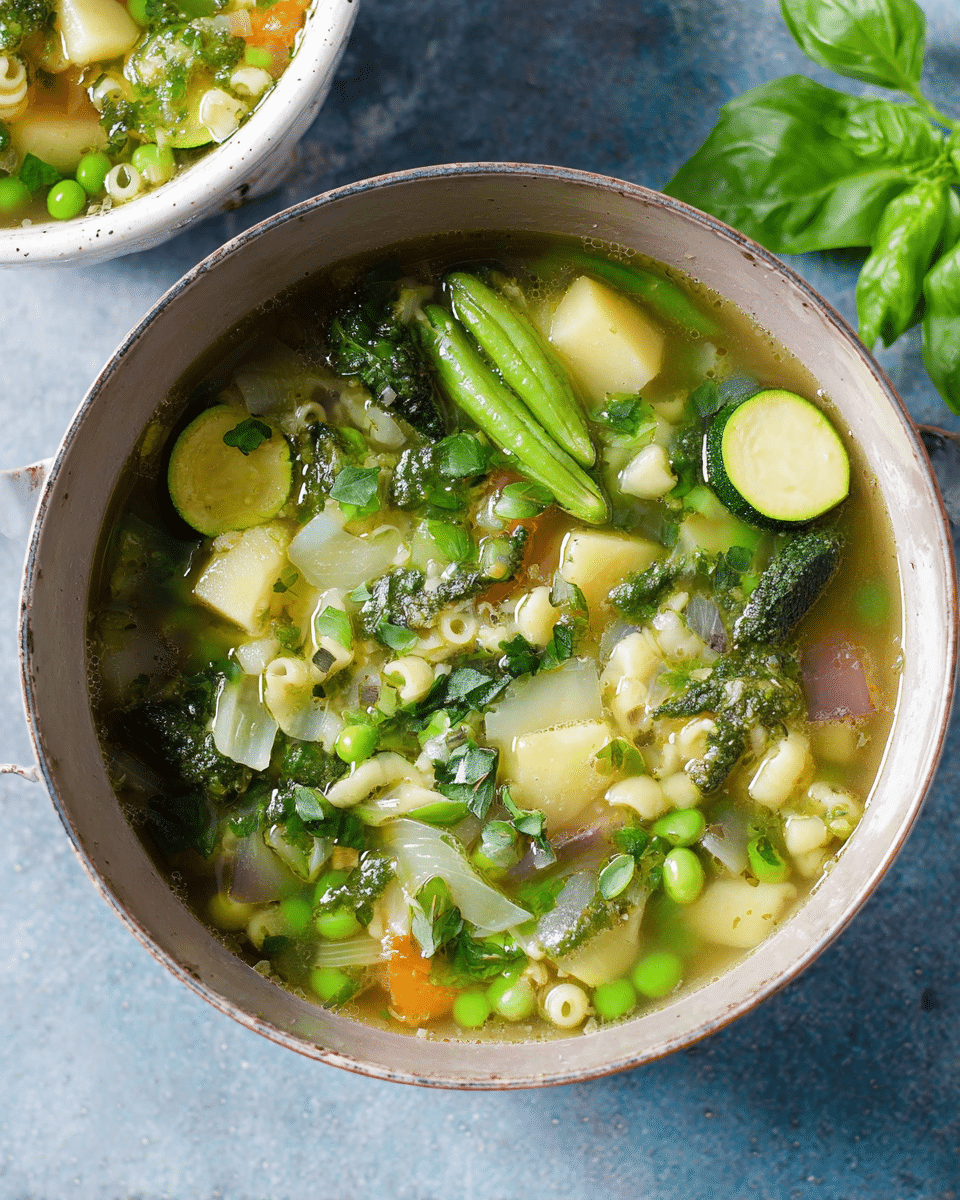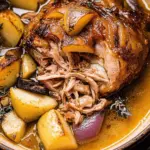The Provencal Soupe au Pistou is a celebration of fresh, seasonal vegetables, brought to life with the aromatic swirl of homemade basil pistou. Originating from the sun drenched kitchens of southern France, this soup brings together zucchini, potatoes, green beans, peas, and tender pasta in a light broth that comforts and nourishes.
What makes this dish truly special is the pistou France’s nut-free cousin of Italian pesto. It’s vibrant, garlicky, and stirred into the soup at the very last moment to preserve the brightness of fresh basil. Whether served with a crusty piece of sourdough or simply on its own, this soup is the essence of a garden-to-table meal.
Full Recipe:
Ingredients:
For the Soup:
-
4 tablespoons frying oil
-
1 medium onion, chopped
-
1 leek, thinly sliced
-
1 celery stalk, sliced
-
1 teaspoon dried thyme (or a couple sprigs of fresh thyme)
-
1 lb (500g) potatoes, cut into 1-inch cubes
-
1 medium zucchini (350g), sliced into half-moons
-
2 large carrots, sliced
-
8 cups (2 liters) water
-
7 oz (200g) green beans
-
1 cup (120g) green peas (frozen)
-
1 can (14 oz / 400g) cannellini beans, with liquid
-
Salt and pepper to taste
-
2.5 cups (300g) small elbow pasta, cooked separately
For the Pistou:
-
4 cups loosely packed fresh basil leaves (40g)
-
2 cloves garlic
-
1/3 cup grated Parmesan cheese (50g)
-
3 tablespoons olive oil
-
Salt to taste
Directions:
-
Prepare all vegetables as described above.
-
In a large pot, heat 2 tbsp oil and sauté onions, leeks, and thyme over low heat for about 8 minutes. Remove and set aside.
-
Add 2 more tablespoons of oil, turn heat to high, and add zucchini, potatoes, carrots, and celery. Cook for 3 minutes, without stirring the first minute, to lightly brown.
-
Return onion mixture to the pot. Pour in 8 cups water. Cover and simmer on low for 15 minutes.
-
Add green beans, bring to a boil, then reduce and simmer for 8 minutes.
-
Stir in green peas and cannellini beans (with liquid), and cook for 2 more minutes. Season with salt and pepper.
-
Meanwhile, prepare pistou: blend basil, garlic, Parmesan, and salt until a chunky paste forms. Slowly whisk or pulse in olive oil on low.
-
To serve, ladle soup into bowls, add a spoonful of cooked pasta and a generous teaspoon of pistou to each bowl. Stir pistou in just before eating.
Prep Time: 25 minutes | Cooking Time: 35 minutes | Total Time: 1 hour
Kcal: 470 kcal | Servings: 6 servings
Soupe au Pistou: A Celebration of Provençal Tradition in a Bowl
There are few dishes in the world that encapsulate the essence of a region as completely as Soupe au Pistou does for Provence. This summer vegetable soup, crowned with a garlicky, herbaceous basil sauce known as pistou, is more than just a recipe it’s a ritual of seasonality, community, and the celebration of sun-ripened produce. Its humble ingredients and rustic charm make it a favorite not just in the south of France, but among home cooks around the globe who seek comfort, freshness, and authenticity.
In this article, we explore the story, cultural roots, variations, health benefits, and modern takes on Soupe au Pistou a dish that has stood the test of time as both a family favorite and a culinary symbol of Southern France.
The Origins of Soupe au Pistou
Soupe au Pistou hails from Provence, a sun kissed region in southeastern France known for its lavender fields, olive groves, vineyards, and colorful produce markets. While it’s often compared to Italian minestrone, Soupe au Pistou is deeply tied to Provençal identity, showcasing the Mediterranean lifestyle and its strong connection to seasonal eating.
The word pistou is derived from the Provençal dialect word “pistare,” meaning “to pound.” This is a direct reference to how the traditional pistou sauce is made with a mortar and pestle. Unlike its Italian cousin pesto, pistou typically excludes pine nuts and sometimes even cheese, relying instead on just a few ingredients: basil, garlic, olive oil, and optionally, grated cheese like Parmesan or Gruyère.
Historically, the soup was made during late summer, when home gardens and local markets overflowed with tomatoes, green beans, zucchini, potatoes, and aromatic herbs. Families would gather around long tables with steaming bowls of soup, each one topped with a fresh spoonful of pistou. It was economical, adaptable, and designed to feed a crowd hallmarks of a truly great traditional dish.
Cultural Significance in French Cuisine
To the people of Provence, Soupe au Pistou is more than nourishment it’s a symbol of the season’s bounty and a staple of communal dining. It’s often served during Bastille Day gatherings, harvest celebrations, and summer feasts. Every Provençal family has its own version, often handed down through generations, with tweaks depending on what was grown in the garden or available at the local market.
Because of its rustic character, the dish rarely features in haute cuisine or Michelin-starred restaurants, but it has an undisputed place in the hearts of the French people. It’s comfort food, rich in memory and meaning, and tied to traditions that prioritize flavor, sustainability, and locality.
Regional and Modern Variations
One of the beautiful aspects of Soupe au Pistou is its flexibility. There’s no singular “authentic” recipe, and over time, families and chefs have adapted the soup to reflect both regional availability and personal preference.
-
Tomatoes or No Tomatoes? Some versions include peeled and chopped tomatoes, while others skip them entirely. In the Nice area, tomatoes are more common, adding acidity and color to the broth.
-
Cheese Inside or On Top? In some regions, grated Emmental or Gruyère is stirred directly into the soup. Others prefer the cheese only in the pistou sauce.
-
With or Without Meat? While traditionally a vegetable soup, some cooks add bits of bacon, sausage, or ham to enrich the broth.
-
Choice of Pasta: From small elbow macaroni to broken vermicelli or orzo, the type of pasta varies widely. Some even replace pasta with pearl couscous or rice.
-
Herb Swaps: While basil is the classic base for pistou, substitutions like parsley or sun-dried tomatoes can create flavorful alternatives.
The beauty of this dish lies in how customizable it is without losing its identity. It invites creativity, making it ideal for both purists and experimental cooks.
Nutritional Benefits
Soupe au Pistou is not just delicious it’s also a nutritional powerhouse. Made almost entirely from vegetables, legumes, herbs, and olive oil, it offers a heart-healthy and plant-based option for those looking to eat clean and seasonally.
Here are just a few of the nutritional benefits:
-
Rich in Fiber: Thanks to beans, peas, and a variety of vegetables, the soup supports digestive health and provides long-lasting satiety.
-
Low in Saturated Fats: With olive oil as the primary fat source, it’s beneficial for heart health.
-
High in Antioxidants: Basil, garlic, and vegetables offer vitamins A, C, and K, as well as a wide array of antioxidants.
-
Protein-Packed: The inclusion of white beans or chickpeas gives a solid protein boost, making it a complete meal.
For those following vegetarian, dairy-free, or gluten-free diets, the soup can be easily adjusted. Omit cheese for a vegan version, use gluten free pasta, or swap in seasonal vegetables like squash, cabbage, or kale as needed.
Serving and Pairing Ideas
The best way to serve Soupe au Pistou is hot, right after swirling in a heaping spoonful of the pistou sauce. The contrast between the bright green herbaceous pistou and the warm, tender vegetables is what makes this dish sing.
Here are a few complementary serving suggestions:
-
With Crusty Bread: A rustic sourdough or French baguette, lightly buttered, is perfect for soaking up the flavorful broth.
-
As a Starter or Main: Serve a smaller portion as a first course for a French-inspired meal, or enjoy a hearty bowl as the main dish.
-
With Wine: Pair it with a crisp white wine like a Sauvignon Blanc or a light rosé from Provence for a truly regional experience.
-
With a Salad: A simple salad of arugula, lemon, and shaved fennel balances the richness of the soup beautifully.
Because the soup contains pasta, it’s best enjoyed fresh. However, you can cook the pasta separately and store it apart from the soup base to keep textures optimal.
Storage and Make-Ahead Tips
Soupe au Pistou is wonderfully meal-prep friendly. The soup base keeps in the refrigerator for 3–5 days and can be frozen for up to three months. Always store the pistou sauce separately, ideally in a sealed jar with a thin layer of olive oil over the top to prevent oxidation.
Avoid freezing the pasta with the soup, as it tends to become mushy. Instead, cook pasta just before serving, or freeze soup portions and add pasta later.
Pro tip: For even deeper flavor, some cooks stir a little pistou into the soup the night before serving, allowing it to infuse. Then they add a fresh swirl of pistou just before eating for brightness.
Conclusion:
Soupe au Pistou is more than a recipe it’s a culinary postcard from the South of France. It’s a bowlful of sunshine and tradition, rooted in home gardens, bustling markets, and generations of family gatherings. Whether you’re making it on a quiet weeknight or serving it to guests at a summer dinner party, this soup embodies the Provençal way of life: simple, seasonal, and incredibly satisfying.
From its adaptable ingredients to its healthful nature, Soupe au Pistou continues to resonate with modern cooks who crave authenticity and comfort. And with each bowl, you’re not just feeding your body you’re nourishing a legacy.






